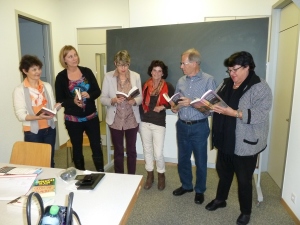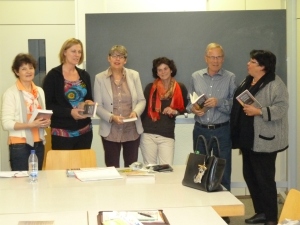By Liza Perrat
It’s no secret. Like many authors, I dislike the marketing side of writing. However, we all know that in today’s competitive marketplace, there’s no shying away from this aspect of the book business.
“Find your niche,” the marketing gurus say. “You can’t pursue them all, so choose what suits you.”
“Like Twitter?” I say.
Despite regularly dipping my toes in the vast Twitter Sea, I’m not convinced of its efficacy. “Buy my book!!!!!!!!!!!!!!!!!!!!!”, “Read my 5-star reviews novel!” certainly turns me off quicker than mouldy fish. I am not about to do the same.
“Facebook then?”
“So, bang on and on about my novels, alienating my FB friends and family?”
And the thought of having a FB author page seems like just one more thing to keep up with, to take away my writing time.
Don't even mention any other of the myriad of marketing and networking platforms available today. I simply don’t have the inclination.
So, what other marketing and networking choices are there?
Well, there is the Bookclub. Just over a year ago, rather than discovering this myself, the ‘Bookclub Niche’ found me.
 When I published my first novel in May 2012, I’d wanted to explore the possibility of speaking at bookclubs, but as I live in a rural French village, there were, for obvious reasons, no English-language bookclubs close by. Then, right before my annual pilgrimage home to Australia last Christmas, a friend who had read Spirit of Lost Angels (first in the L’Auberge des Anges trilogy) contacted me.
When I published my first novel in May 2012, I’d wanted to explore the possibility of speaking at bookclubs, but as I live in a rural French village, there were, for obvious reasons, no English-language bookclubs close by. Then, right before my annual pilgrimage home to Australia last Christmas, a friend who had read Spirit of Lost Angels (first in the L’Auberge des Anges trilogy) contacted me. “All the girls in my reading group have read your book. Would you like to come to our Bookclub Christmas party and talk about it?”
“Oh yes, that would be nice,” I said, thinking, You bet I would!
Knowing only one member of this group, I was a bit nervous when I showed up and saw them all clutching copies of Spirit of Lost Angels. My fingers shook a little as I passed out copies of my carefully-prepared Question/Answer sheet, and I realised this was a serious group of demanding and unforgiving readers. But after several bottles of bubbly and some tasty food, the mood certainly lightened up and everyone, including me, was soon chattering away.
 |
 They asked questions about the writing and research process and gave me some excellent feedback on points they did and did not like about the book. I filed it all away for my next novel, when I was considering the story from the reader’s point of view.
They asked questions about the writing and research process and gave me some excellent feedback on points they did and did not like about the book. I filed it all away for my next novel, when I was considering the story from the reader’s point of view. And you know what, it was Great Fun!
An old school-friend from a different bookclub (Bulli bookclub) had also contacted me around the same time. Still serious readers, this group was entirely different, and, after a short time speaking about Spirit of Lost Angels, we spent the evening drinking Margaritas and eating pizza.
So, different groups of people, different dynamics, but again … Great Fun.
Word travels fast in the city of Wollongong, New South Wales, and this year the Keiraville bookclub asked me to come and speak about Spirit of Lost Angels.
 An excellent lunch of fine food and wine provided the backdrop for an in-depth discussion about where story ideas come from, how I organise my writing and research schedule (what schedule?), and how long it takes to write a book. I answered their questions eagerly and we spent hours talking about novels in general – our likes and dislikes – which, as an avid reader, I found most inspiring. I signed their copies of Spirit of Lost Angels, and passed around our Triskele Books bookmarks. I also spoke about the other Triskele books, and handed out my colleagues’ bookmarks in a sly bit of team-promotion.
An excellent lunch of fine food and wine provided the backdrop for an in-depth discussion about where story ideas come from, how I organise my writing and research schedule (what schedule?), and how long it takes to write a book. I answered their questions eagerly and we spent hours talking about novels in general – our likes and dislikes – which, as an avid reader, I found most inspiring. I signed their copies of Spirit of Lost Angels, and passed around our Triskele Books bookmarks. I also spoke about the other Triskele books, and handed out my colleagues’ bookmarks in a sly bit of team-promotion. The other evening, the Bulli girls again invited me to join them for more Margaritas and pizza at Ryan’s Pub, to talk about my second novel in L’Auberge des Anges trilogy, Wolfsangel.
Of particular interest was the true World War 2 crime that inspired Wolfsangel.
“What’s next?” they asked.
I told them a little about Midwife Héloïse – Blood Rose Angel, the final book in L’Auberge des Anges historical trilogy.
So, if this type of marketing/networking appeals to you, you might be wondering how one finds willing bookclubs.
The most obvious place to start is with friends. An internet search will probably show up local bookclubs. Or just ask around your local area. So many people enjoy reading groups these days, and will jump at the chance to have an author speak at one of their meetings. Perhaps offer a free copy of your book to a group member, and a speaking event, if they would consider it for their club. No obligation of course!
Take along your promo material: bookmarks, postcards, whatever you have. I’m trying to convince my Triskele colleagues to get pens or mugs or something made up, to hand out at events like this. People love goodie bags.
Prepare copies of a Q/A sheet or a study guide to hand around. This post by my Triskele colleague, JJ Marsh will help you to make a study guide. Some groups will welcome this, others won’t be bothered. As I said … different groups, different dynamics.
If the event is successful, send a collective email thanking the people for inviting you, and offer to attend a future session for your next book. If possible, and appropriate, keep contact with the group afterwards.
“So, do you still hate marketing and networking?”
I enjoy meeting new people and eager readers. I get to rave on about my books without my audience yawning or playing on their mobile phone. I spread the word about my novels, and those of my colleagues, to willing listeners. I’m gaining a readership, person by person, and isn’t that what they say about marketing: it’s no sprint, but a marathon?
So, nope, I love it!


















